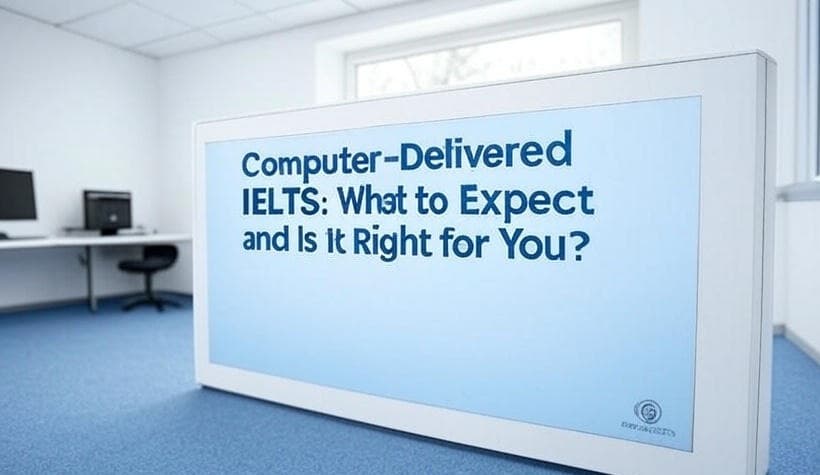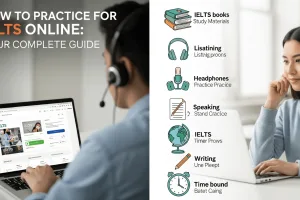Introduction
In general, there are two kinds of IELTS exams that you can choose to take: computer-based and paper-based. The computer version is newer and is becoming more popular as people grow more comfortable with technology.
Just like the paper version, the computer-delivered IELTS includes four parts: Listening, Reading, Writing, and Speaking. The first three sections are done on a computer at an official test center, while the Speaking test is still a face-to-face session, just like the traditional format.
Even though the test is on a computer, you still need to go to a test center to take the exam, and you are allowed to use pen and paper during the test for planning and brainstorming.
The content, timings, question types, scoring, and results format are exactly the same in both versions.
What are the key differences?
- Fewer People in the Room: Computer-based tests usually have fewer candidates per room, which means less distraction and noise.
- Built-in Timer: A digital timer on your screen shows how much time you have left. It helps with time management, though it doesn’t show seconds, so be careful near the end! Also, you’re not allowed to bring a watch.
- Listening Section: In the paper test, you have 10 extra minutes to transfer answers to the answer sheet. On the computer, you type your answers as you go, and only get 2 minutes to review them at the end.
- Reading Section: The ability to copy and paste answers can reduce spelling mistakes. You also save time since there’s no need to transfer answers to a separate sheet.
- Writing Section: If you’re a fast typist, this section may feel easier. No need to ask for extra paper! But be careful with typos—they can affect your grammar and vocabulary scores.
- Handwriting vs. Typing: In the paper test, messy handwriting can lower your score if the examiner can’t read it. In the computer test, slow or inaccurate typing might hold you back.
- Layout Advantage: In the computer version, questions appear right next to the text, so it’s easier to stay focused and avoid flipping pages or losing your place like it often happens in the paper-based test.
- More Flexible Scheduling: Computer-based tests are offered more often, so it’s easier to find a date that works for you. Plus, you’ll get your results in just 3–5 days, compared to up to 30 days for the paper test.
Which one is better for you?
We mentioned some differences between the two kinds. If you’re still unsure which one is right for you, take a look at the chart below—it might help you decide.
| Paper-based IELTS | Computer-based IELTS |
|---|---|
| You are not comfortable using a computer | You can type quickly |
| You don’t mind waiting a month for results | You need your result in less than a week |
| You can manage time using a clock | You need an automatic reverse timer |
| You tend to avoid typos | You mostly type accurately |
| You’re okay waiting for a specific test date | You need to take the exam sooner or on a specific date |
What Is the Test Format Like?
As mentioned earlier, both versions follow the exact same structure. Like the traditional paper test, the computer version consists of four parts: Listening, Reading, Writing, and Speaking. The Speaking section is still done face-to-face. The other three sections are in the same format but delivered via computer.

After arriving at your test center, you can begin your exam by clicking on the “Start test” button. There are icons to pause and resume your exam in case of emergency (like needing to go to the bathroom). You’ll also find options to change the font size or screen background. Additionally, there is a navigation menu bar to switch between questions in each section. And you can use the review button to mark a question for later action.
- Listening Section: You need to enter your answers immediately after hearing them, as you don’t have extra time to transfer answers. However, you do get 2 minutes at the end to review.
- Reading Section: The passage appears on the left side of the screen, and the questions appear on the right. You can also highlight text or add notes using the available tools.
- Writing Section: You can start with either Task 1 or Task 2. There’s a word count feature at the bottom of the screen to help you meet the minimum word requirement. Keep in mind, there’s no spell check—so spelling and grammar accuracy are important to avoid losing points.
Final thoughts
As technology advances, more candidates are choosing to take the IELTS exam online on a computer. If you are planning to go this route, our website offers all the practice you need to gain confidence in taking the IELTS on a screen by providing IELTS mock tests. The more you practice, the better you’ll manage your time, avoid errors, and improve your typing speed.
If you choose the paper-based version, our platform still has you covered. Since the content and question types are the same, practicing here will prepare you well.
Whatever version you decide to take, Langogh is here to support you. Practice as much as you can to become fully comfortable with the exam.
Good luck — and remember, the more you practice, the more confident you’ll feel on test day!



